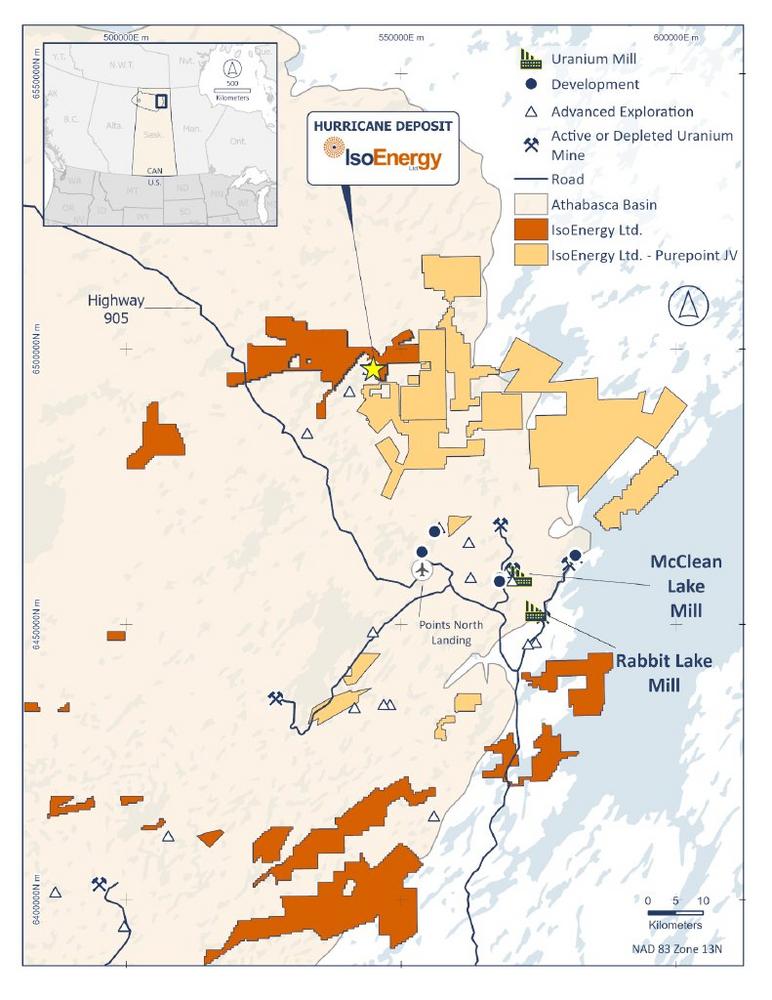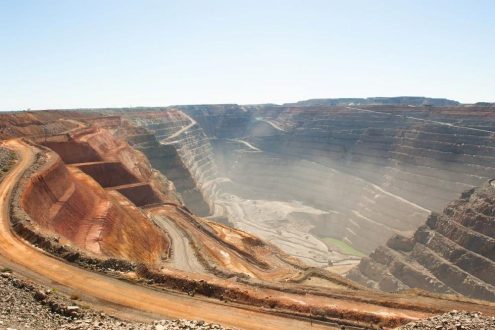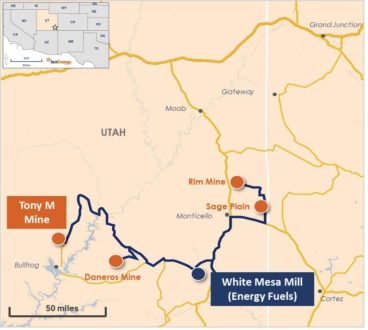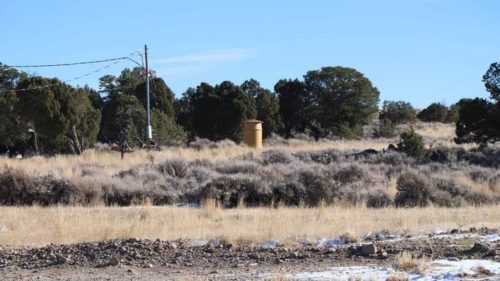
IsoEnergy Summer Drilling Intersects Multiple Areas of Radioactivity Highlighting the Prospectivity of the Larocque Trend
Highlights
- Drilling confirmed prospectivity for additional mineralization at the Project regionally through the identification of two new high priority zones (Areas D and E) and immediately adjacent to Hurricane, referred to as Hurricane East (Figure 3).
- First pass drilling in Areas D and E returned elevated radioactivity associated with significant alteration, enhancing the prospectivity of the Project’s eastern extent.
– In Area E, a 1km by 2km ANT anomaly located 8km east of Hurricane, five holes were drilled highlighted by hole LE24-192 which intersected 2.0m at 495 parts per million uranium partial (“ppm U-p”) and 3,410 counts per second (“cps”), including 0.5m at 1,110 ppm U-p and 7,483 cps (Figure 4).
– In Area D, a 2.5km by 1km ANT anomaly located 8 km east of Hurricane, five holes were drilled highlighted by hole LE24-174 which intersected 3.5m, from 254m, at 26.2 ppm U-p and 257 cps and 0.2m at 1,303 cps (Figure 5).
– These results are comparable to pre-discovery holes drilled by Cameco just 40 meters from the high-grade Hurricane Deposit, KER-11, which returned 0.5m at 518.0 ppm U-p and KER-12 (Figure 4). We believe this emphasizes the strong proximal potential within the geochemical halos of the known deposits, where sharply defined uranium mineralization boundaries are evident.
- Drilling in Hurricane East within 600 meters of Hurricane returned elevated radioactivity, indicating potential for resource expansion.
– A single hole drilled 290m east of Hurricane, LE24-188, intersected 2.1m at 1,847 cps, indicating a potential for near resource expansion (Figure 6).
– In Area B, a 250m by 180m ANT target anomaly centred 500m east of Hurricane, seven holes were drilled. Hole LE24-165 intersected 6.0 m at 1,359 cps, including a higher-grade interval of 0.5m at 3,067 cps.
– These results suggest that the Hurricane resource may remain open for further expansion.
- Additional results are expected in the coming weeks with 33% of the geochemical results received to date (Table 1). Initial results are highly encouraging, with strong hydrothermal alteration and elevated geochemical signatures – key indicators typically associated with uranium mineralization.
- Follow up drilling commencing in January 2025 is currently anticipated with a focus on high-priority areas including D, E and Hurricane East, as well as additional first pass drilling in other untested ANT anomalies (Figure 3).
Dr. Dan Brisbin, Vice President Exploration, commented, “Our summer drill results at Larocque East are highly encouraging. The structural disruption, bleaching, desilicification and clay alteration intersected within and adjacent to the ANT velocity anomalies are all hallmarks of Athabasca uranium deposits. The significantly anomalous radioactivity and sandstone uranium geochemistry are indicative of the fertility of these alteration zones; and several kilometres of strike length along graphitic-pyritic conductor corridors east of the Hurricane Deposit provide ample exploration space for potential additional discoveries along the Hurricane trend.”
The Larocque Trend is a northeast-trending regional structural feature that extends over 160 kilometres, hosting numerous anomalous uranium occurrences (Figure 2). Most notably, it is home to the Hurricane Deposit, a discovery that has significantly enhanced the prospectivity of the entire trend, further underscoring its potential for additional high-grade uranium discoveries.
Recent exploration drilling and geophysical programs have successfully defined the alteration and geochemical footprint of the Hurricane Deposit. While the mineralized footprint is relatively small—ranging from 20 to 125 meters wide, 375 meters long, and 2 to 12 meters thick (Figures 4)—it is hosted within a much larger zone of hydrothermal clay alteration, spanning up to 500 meters wide, 1 km long, and 200 to 300 meters thick. Within this broader alteration zone, the boundaries of the uranium mineralization are remarkably sharp and have been precisely delineated by drilling (Figure 4). Typically, uranium grades in the Hurricane Deposit decline sharply, dropping from greater than 1% to less than 20 ppm U-p over 30 metres in the both the horizontal and vertical directions. This abrupt decrease in uranium grade over such short distances presents a challenge in identifying additional high-grade zones. However, the broader, low-level geochemical signature of uranium mineralization provides a larger, more accessible target for initial drill testing, offering valuable vectors for potential follow-up drilling. This understanding has informed the design and analysis of the recent summer drill program (Figure 3), with drilling in seven of ten ANT anomalous target areas defined by 2023 and 2024 surveys. As a result, three target areas – East Hurricane, D and E – have been prioritized for future drill testing, with the details of the high priority targets reviewed in figures and tables below. Integration of new geological, mineralogical, geochemical and geophysical (ANT) information obtained in 2024 with historical information is already underway to generate new drill targets.
Corporate Update
The Company announces that Dr. Darryl Clark, Executive Vice President of Exploration and Development, has resigned to pursue new opportunities. Dr. Clark will, however, continue to support the exploration team in his new role as Technical Advisor.
Dr. Dan Brisbin has assumed accountability for IsoEnergy’s exploration activities in Canada, USA, and Australia. Dan has 45 years exploration and mine geology experience, including 20 years in the Athabasca Basin and other uranium districts. He holds a PhD in economic geology from Queen’s University and is a Professional Geoscientist in Saskatchewan, Manitoba, and Ontario.
Quality Assurance and Quality Control (QA/QC)
Quality Assurance in uranium exploration benefits from the use of down-hole gamma probes and hand- held scintillometers/spectrometers, as discrepancies between radioactivity levels and geochemistry can be readily identified.
IsoEnergy implemented its QA/QC program in 2019. CRMs are used to determine laboratory accuracy in the analysis of mineralized and unmineralized samples. Duplicate samples are used to determine analytical precision and repeatability. Blank samples are used to test for cross contamination during preparation and analysis stages. For each mineralized drill hole at least one certified reference material (CRM) blank, one CRM standard, and one duplicate sample (MDUP) is inserted in the MINZ sample series. One of two CRM standards is used: OREAS 124 (O124) if maximum grade is <1% eU3O8 or BL-5 (BL5) if maximum grade is >1% eU3O8.
For unmineralized samples such as composite and spot samples, field insertions are made at the rate of 1% for blanks, 2% for duplicates and 1% CRMs. The following protocols are followed:
- Sample IDs ending in 00 will be certified blanks (BLA1).
- Sample IDs ending in 25 and 75 will be duplicates (DUPL) of the preceding sample.
- Sample IDs ending in 50 will be CRM OREAS 120 (O120).
In addition to IsoEnergy’s QA/QC program, SRC conducted an independent QA/QC program, and its laboratory repeats (REPT), non-radioactive laboratory standards (LSTD), and radioactive lab standards (BL2A, BL4A, BL5) were monitored and tracked by IsoEnergy staff.
No QA/QC samples are inserted for reflectance samples as analyses are semi-quantitative only.
Assaying and Analytical Procedures
Composite and spot samples were shipped to SRC Geoanalytical Laboratories in Saskatoon for sample preparation and analysis. SRC is an independent laboratory with ISO/IEC 17025: 2005 accreditation for the relevant procedures.
The samples were then dried, crushed, and pulverized as part of the ICPMS Exploration Package (codes ICPMS1 and ICPMS2) plus boron (code Boron). Samples were analyzed for uranium content, a variety of pathfinder elements, rare earth elements, and whole rock constituents with the ICPMS Exploration Package (plus boron). The Exploration Package consists of three analyses using a combination of inductively coupled plasma – mass spectrometry, inductively coupled plasma-optical emission spectrometry (“ICP- OES”), and partial or total acid digestion of one aliquot of representative sample pulp per analysis. Total digestion is performed via a combination of hydrofluoric, nitric, and perchloric acids while partial digestion is completed via nitric and hydrochloric acids. In-house quality control performed by SRC consists of multiple instrumental and analytic checks using an in-house standard ASR316. Instrumental check protocols consist of two calibration blanks and two calibration standards. Analytical protocols require one blank, two QA/QC standards, and one replicate sample analysis.
Samples with radioactivity over 350 CPS measured by Radiation Solutions RS- 125 were also shipped to SRC. Sample preparation procedures are the same as for the ICPMS Exploration Package, samples were analyzed by ICP-OES only (Code ICP1) and for U3O8 using hydrochloric and nitric acid digestion followed by ICP-OES finish, capable of detecting U3O8 weight percent as low as 0.001%.
Selective samples to be analyzed for gold, and in some instances, platinum and palladium, by fire assay using aqua regia digestion with ICP-OES finish. Analytical protocols utilized replicate sample analysis; however, no in-house standards were used for these small batches. Boron analysis has a lower detection limit of 2 ppm and is completed via ICP-OES after the aliquot is fused in a mixture of sodium superoxide (NaO2) and NaCO3. SRC in-house quality control for boron analysis consists of a blank, QC standards and one replicate with each batch of samples.
Borehole Radiometric Probing Method
All successfully completed 2024 drillholes are radiometrically logged using calibrated downhole Mount Sopris 2PGA-1000 probe which collects reading every 10 cm along the length of the drillhole. The 2PGA-probe was sourced from Alpha Nuclear and was calibrated for the summer 2024 program by IsoEnergy geologists at Saskatchewan Research Council facility in Saskatoon in May 2024. The total count gamma readings using the 2PGA-1000 probe may not be directly or uniformly related to uranium grades of the interval measured and are only a preliminary indication of the presence of radioactive minerals.
Sample Collection Methods
All drill core is systematically logged to record its geological and geotechnical attributes by IsoEnergy geologists and geological technicians. All drill core is systematically photographed and scanned for radioactivity with a handheld Radiation Solutions RS-125 spectrometer. IsoEnergy geologists mark sample intervals and sample types to be collected based on geological features in the core and on radioactivity measured with the RS-125 in counts per second (CPS). Geologists and geological technicians complete the on-site collection of several types of samples from drill cores.
Composite geochemistry samples consist of roughly one-centimetre-long chips of core collected every 1.5 m to geochemically characterize unmineralized sections of sandstone and basement. Composite sample lengths are between five and ten m (typically 3 to 7 chips per sample). For five metres above and two metres below the unconformity composite sample intervals are 0.5 m long and the samples are composed of several chips of core in each interval.
Split-core “spot” (i.e., representative) samples are collected through zones of significant but unmineralized alteration and/or structure. Spot sample length varies depending on the width of the feature of interest but are generally 0.5 m in length.
Split-core mineralization (“MINZ”) samples are collected through zones of elevated radioactivity exceeding 350 CPS measured via RS-125 handheld spectrometer. MINZ samples are generally 0.5 m in length. One half of the core is collected for geochemical analysis while the remaining half is returned to the core box for storage on site. Intervals covered by MINZ samples are contiguous with and do not overlap intervals covered by composite samples.
Systematic short-wave infrared (“SWIR”) reflectance (“REFL”) samples are collected from approximately the middle of each composite sample for analysis of clays, micas, and a suite of other generally hydrous minerals which have exploration significance. Spot reflectance samples are collected where warranted (i.e., fracture coatings). Reflectance samples are not collected through mineralized zone.
For lithogeochemistry samples, sample tags with the sample number are placed in the sample bags before they are sealed and packed in plastic pails or steel drums for shipment to the Saskatchewan Research Council (“SRC”) in Saskatoon, Saskatchewan. A second set of sample tags with the depth interval and sample number are stapled in the core box at the end of each sample interval. A third set of sample tag with the drill hole number, sample depth interval, and sample number is retained in the sample book for archiving. SWIR reflectance samples are tagged in a similar fashion as lithogeochemistry samples.
Geologists enter all geological, geotechnical and sample interval data into IsoEnergy’s drill hole database during core logging.
Sample Shipment and Security
Drill core was delivered from the drill to IsoEnergy’s core handling facilities at the Larocque Lake camp thereafter. Individual core samples were collected at the core facilities by manual splitting. They were tagged, bagged, and then packaged in five-gallon plastic buckets or steel IP-2 drums for shipment to SRC Geoanalytical labs in Saskatoon. Shipment to the laboratory was completed by IsoEnergy’s expeditor, Little Rock Enterprises of La Ronge, Saskatchewan and by Points North Freight Forwarding Inc. of Points North Landing, Saskatchewan.
Qualified Person Statement
The scientific and technical information contained in this news release was reviewed and approved by Dr. Dan Brisbin, P.Geo., IsoEnergy’s Vice President, Exploration, who is a “Qualified Person” (as defined in NI 43-101 – Standards of Disclosure for Mineral Projects).
For additional information regarding the Company’s Larocque East Project, including its quality assurance and quality control procedures applied to the exploration work described in this news release, please see the Technical Report titled “Technical Report on the Larocque East Project, Northern Saskatchewan, Canada” dated August 4, 2022, on the Company’s profile at www.sedarplus.ca.
About IsoEnergy Ltd.
IsoEnergy Ltd. (TSX: ISO) (OTCQX: ISENF) is a leading, globally diversified uranium company with substantial current and historical mineral resources in top uranium mining jurisdictions of Canada, the U.S., and Australia, at varying stages of development, providing near, medium, and long-term leverage to rising uranium prices. IsoEnergy is currently advancing its Larocque East Project in Canada’s Athabasca Basin, which is home to the Hurricane deposit, boasting the world’s highest grade Indicated uranium Mineral Resource.
IsoEnergy also holds a portfolio of permitted, past-producing conventional uranium and vanadium mines in Utah with a toll milling arrangement in place with Energy Fuels Inc. These mines are currently on stand-by, ready for rapid restart as market conditions permit, positioning IsoEnergy as a near-term uranium producer.
For More Information, Please Contact:
Philip Williams
CEO and Director
info@isoenergy.ca
1-833-572-2333
X: @IsoEnergyLtd
www.isoenergy.ca
In Europe:
Swiss Resource Capital AG
Jochen Staiger & Marc Ollinger
info@resource-capital.ch
www.resource-capital.ch
Neither the TSX Exchange nor its Regulations Services Provider (as that term is defined in the policies of the TSX Exchange) accepts responsibility for the adequacy or accuracy of this release.
Forward-Looking Information
The information contained herein contains “forward-looking statements” within the meaning of the United States Private Securities Litigation Reform Act of 1995 and “forward-looking information” within the meaning of applicable Canadian securities legislation. “Forward-looking information” includes, but is not limited to, statements with respect to the activities, events or developments that the Company expects or anticipates will or may occur in the future, including, without limitation, the anticipating timing for reporting of the remaining results and planned exploration activities and the anticipated results thereof. Generally, but not always, forward-looking information and statements can be identified by the use of words such as “plans”, “expects”, “is expected”, “budget”, “scheduled”, “estimates”, “forecasts”, “intends”, “anticipates”, or “believes” or the negative connotation thereof or variations of such words and phrases or state that certain actions, events or results “may”, “could”, “would”, “might” or “will be taken”, “occur” or “be achieved” or the negative connotation thereof.
Such forward-looking information and statements are based on numerous assumptions, including among others, that the results of planned exploration activities are as anticipated and will be reported when anticipated, the price of uranium, the anticipated cost of planned exploration activities, that general business and economic conditions will not change in a material adverse manner, that financing will be available if and when needed and on reasonable terms, that third party contractors, equipment and supplies and governmental and other approvals required to conduct the Company’s planned exploration activities will be available on reasonable terms and in a timely manner. Although the assumptions made by the Company in providing forward-looking information or making forward-looking statements are considered reasonable by management at the time, there can be no assurance that such assumptions will prove to be accurate.
Forward-looking information and statements also involve known and unknown risks and uncertainties and other factors, which may cause actual events or results in future periods to differ materially from any projections of future events or results expressed or implied by such forward-looking information or statements, including, among others: negative operating cash flow and dependence on third party financing, uncertainty of additional financing, no known mineral reserves, the limited operating history of the Company, the influence of a large shareholder, alternative sources of energy and uranium prices, aboriginal title and consultation issues, reliance on key management and other personnel, actual results of exploration activities being different than anticipated, changes in exploration programs based upon results, availability of third party contractors, availability of equipment and supplies, failure of equipment to operate as anticipated; accidents, effects of weather and other natural phenomena and other risks associated with the mineral exploration industry, environmental risks, changes in laws and regulations, community relations and delays in obtaining governmental or other approvals and the risk factors with respect to the Company set out in the Company’s filings with the Canadian securities regulators and available under IsoEnergy’s profile on SEDAR+ at www.sedarplus.ca.
Although the Company has attempted to identify important factors that could cause actual results to differ materially from those contained in the forward-looking information or implied by forward-looking information, there may be other factors that cause results not to be as anticipated, estimated or intended. There can be no assurance that forward-looking information and statements will prove to be accurate, as actual results and future events could differ materially from those anticipated, estimated or intended. Accordingly, readers should not place undue reliance on forward-looking statements or information. The Company undertakes no obligation to update or reissue forward-looking information as a result of new information or events except as required by applicable securities laws.
Swiss Resource Capital AG
Poststrasse 1
CH9100 Herisau
Telefon: +41 (71) 354-8501
Telefax: +41 (71) 560-4271
http://www.resource-capital.ch
CEO
Telefon: +41 (71) 3548501
E-Mail: js@resource-capital.ch
Telefon: +41 (71) 354-8501
E-Mail: mo@resource-capital.ch
![]()





